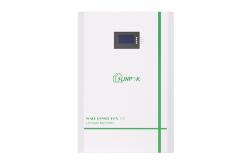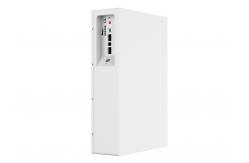48v 100ah Lithium Solar Battery Lifepo4 Solar Power Storage Systems
|
|
Characteristics of a Battery Energy Storage System
Response Time — Amount of time required for a storage system to go from standby mode to full output. This performance criterion is one important indicator of the flexibility of storage as a grid resource relative to alternatives. Most storage systems have a rapid response time, typically less than a minute. Pumped hydroelectric storage and compressed air energy storage tend to be relatively slow as compared with batteries.
Ramp Rate — Ramp rate indicates the rate at which storage power can be varied. A ramp rate for batteries can be faster than 100% variation in one to a few seconds. The ramp rate for pumped hydroelectric storage and for compressed air energy storage is similar to the ramp rate of conventional generation facilities.
Energy Retention or Standby Losses — Energy retention time is the amount of time that a storage system retains its charge. The concept of energy retention is important because of the tendency for some types of storage to self-discharge or to dissipate energy while the storage is not in use.
Energy Density — The amount of energy that can be stored for a given amount of area, volume, or mass. This criterion is important in applications where area is a limiting factor, for example, in an urban substation where space could be a limiting constraint to site energy storage.
Power Density — Power density indicates the amount of power that can be delivered for a given amount of area, volume, or mass. In addition, like energy density, power density varies significantly among storage types. Again, power density is important if area and/or space are limited or if weight is an issue.
Safety — Safety is related to both electricity and to the specific materials and processes involved in storage systems. The chemicals and reactions used in batteries can pose safety or fire concerns.
Life span — measured in cycles.
Depth of Discharge (DoD) — Refers to the amount of the battery’s capacity that has been utilized. It is expressed as a percentage of the battery’s full energy capacity. The deeper a battery’s discharge, the shorter the expected life time. Deep cycle is often defined as 80% or more DoD.
Ambient temperature — Has an important effect on battery performance. High ambient temperatures cause internal reactions to occur, and many batteries lose capacity more rapidly in hotter climates.
|
||||||||||||||||||||||||||||||||||||||||||||||||||||||||||||||||||||||||||||||||
| Product Tags: 48v 100ah Lithium Solar Battery 48v 100ah Lithium Battery Lifepo4 Solar Power Storage Systems | ||||||||||||||||||||||||||||||||||||||||||||||||||||||||||||||||||||||||||||||||

|
48V 600Ah Low Voltage 30kWh 32kWh Lithium Ion Battery Energy Storage Akku LiFePO4 Lithium Battery At Home |

|
51.2V 628Ah 600Ah LiFePO4 Solar Energy Storage System BMS Battery House Home Floor-Mounted CAN Communication |

|
8000 Cycles 15kw Lifepo4 15kwh Lithium Ion Solar Battery 51.2v 300AH for Home Energy Storage |

|
10000 Cycles 20kw Lifepo4 20kwh Lithium Ion Solar Battery 51.2v 400AH for Home Energy Storage |

|
51.2V 200Ah Solar Energy Storage System 10Kwh Solar Powerwall 48V 200Ah LiFePO4 Solar Lithium Battery |

|
51.2V 200ah Solar LiFePO4 Lithium Ion Battery Pack 48V LiFePO4 10kwh Home Energy Storage System |


